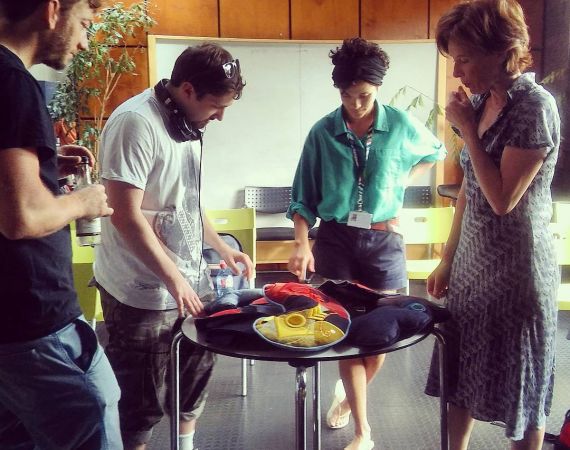Lunchtime talk write-up
Posted on Mon 10 Jul 2017
Tactile Interfaces for Older People
At this week’s Lunchtime Talk studio resident Annie Lywood introduced Bonnie Binary, a pioneering research into E-Textiles, exploring the potential of soft, interactive and decorative textile interfaces that enable older people to access and manage their immediate environment and memories. She…

Posted by
Speaker
At this week’s Lunchtime Talk studio resident Annie Lywood introduced Bonnie Binary, a pioneering research into E-Textiles, exploring the potential of soft, interactive and decorative textile interfaces that enable older people to access and manage their immediate environment and memories. She shared with us her current Brigstow funded project, and explained the potential of tactile interfaces to enable user-friendly control of useful technology in the home.
Annie specialises in using her design and making skills to create bespoke costumes, objects and interactive surfaces to create meaningful, tactile encounters. She also runs workshops and introductory courses to help other get started combining textiles and technology.
Five Things I Learned
1. Annie recently finished MA in design focusing on the interface of e-textiles. Annie set up e-textiles consultancy Bonnie Binary, which focuses on simple and easy to use textile interfaces and decorative technology to create approachable friendly lifestyle and well-being products. Some of her creations include mood cushions, tactile toys and Valkyrie’s light up jacket, which has textile touch slider that controls lights inside the jacket. Annie wants to make mainly badges and accessories in future, as she doesn’t need to embed them in clothing, making them less costly and more sustainable.
2. Annie is currently working with Southampton and Nottingham Trent University researching the use of e-yarn with a focus on human interaction. Annie will be learning how to stitch circuits into clothing in Germany. In addition to this, Annie is working on textile interfaces for older people- funded by Brigstow research institute- working with Tangible Memories. Annie believes textile interfaces have a role to play in targeting communication issues and loves working in a interdisciplinary way.
3. Annie has been through vast amounts of proto-types and testing for her e-textiles, finding out what people wanted to be able to do with them, talking with people from care homes. Did they prefer the technology to be concealed inside cushions or furniture? How accessible is it for older people? The carers had set Annie strict criteria - no visible wires, must be comfortable for the participants, had to be washable and low maintenance, must not be hard to use. Annie’s main focus is on enabling social interaction and access to memories for early stage dementia using existing tech in care homes, such as TVs or laptops.
4. Participants loved the feel and memories of textiles, however Annie found that older people were using it, but not realising they were changing anything on a computer or TV screen. Annie wants to add a haptic response like a vibration, light or sound to alert the user they have changed something. Other concerns Annie is addressing is how to prevent the accidental pressing of buttons. Annie found it challenging using her e-textiles with the focus group as they needed a lot of one-to-one support while using the textile remotes and were all at different levels of capability.
5. Annie told us that some of the feedback she received were things like “Why bother?” and “What’s it for?”. Annie found some of the feedback disheartening, but also really important to learn and to improve her designs. Annie has since thought about whether participants were confusing the use of a cushion with the use of a controller? A cushion already has a purpose so by creating a different name for the textile interface or completely changing the shape it might elevate some.
In the future Annie will focus down on the focus group and add an app/website element so that user experience can be monitored, personalised and updated by the care provider.

